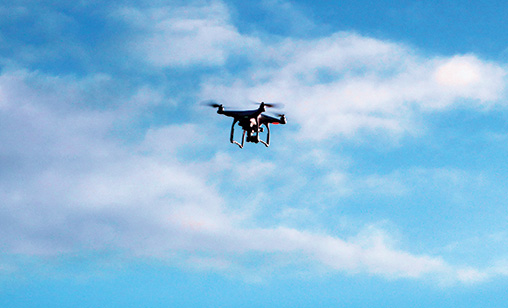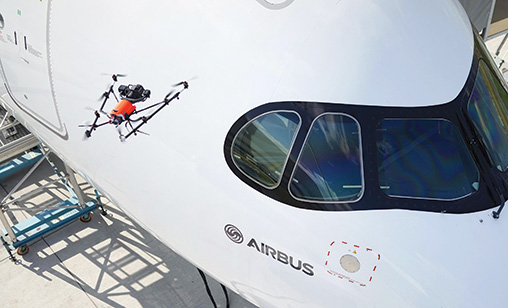Main Story
Industry must act fast to regulate drone use
Rapid growth in drones is an increasing risk to flight operations, but it also is a positive step forward in industry MRO processes and digital communications. Chief correspondent, Tom Ballantyne, reports on the need for standardization of commercial and individual drone use to ensure the safety of airline passengers, employees and civilians.
May 1st 2018
As Air New Zealand’s NZ92 B777-200 was close to landing at Auckland Airport last month, its pilots were suddenly confronted with a crisis that is becoming increasingly common at airports around the world. Read More » Just five metres away, in the airplane’s flight path, was a drone. It was so close to the aircraft the crew believed it might be sucked into an engine.
“NZ92 was just metres away from a serious incident. The pilots spotted the drone at a point in the descent where it was not possible to take evasive action,” said the airline’s chief operations integrity and standards officer, Captain David Morgan.
 |
In the event the aircraft, with 278 passengers onboard, landed safely, but Morgan, like many in the industry wants tougher regulations on drone use. It was clear that “tougher deterrents” were needed to prevent “reckless drone use around airports”, he said, and added there should be prison terms for drone operators who endangered lives.
Auckland, which experienced another drone near miss earlier in March that closed down flight operations for 30 minutes, is not the only airport to face drone disruption. There have been similar incidents across the world, including in China, Japan, South Korea and Dubai.
In China, 10,000 passengers were stranded for 24 hours last year after more than 240 flights at a Chongqing airport were disrupted by drones. Sixty flights had to be cancelled and 40 others were diverted to other airports because of the interference.
Chinese aviation statistics show the number of cases of drones affecting airport services across the country increased from four in 2015 to 23 in 2016, with the number understood to have risen again last year. In April, Hong Kong authorities launched an extensive consultation aimed at tightening the broad and rudimentary regulatory environment for drones. At present, they are banned from use within five kilometres of an airport.
Figures from a 2017 Australian Transport Safety Bureau (ATSB) report revealed that from 2012 to 2016, more than half of all drone incidents were near misses with aircraft. More than 60% of the incidents happened in 2016.
| Rules on drone use vary worldwide Under New Zealand law, drones must be kept at least 4km from an airport. Individual drone operators who breach the rules can be fined up to US$3,600. In China, where drones that weigh between 7kg and 116Kg need to be licensed by the Civil Aviation Administration of China (CAAC). Fines can be as high as $15,500. A drone flying in China that weighs more than 116Kg requires a pilot license and UAV certification for operation. In Japan, drones must be flown at least 9 kms from airports, but in South Korea, the limit is 5.5 km from airports or any area in which aircraft are operating. In the United Arab Emirates (UAE) the distance is 5 km, although airports in Dubai and Sharjah still regularly suffer disruption to operations because of drones. |
Last year, the problem escalated with a 75% increase in the number of drones in near misses with aircraft. The report said the number of incidents involving drones was “increasing exponentially”.
In Singapore, the government passed a bill in May, 2016 to tighten rules on drone use. Then Transport Minister, Lui Tuck Yew, said there had been more than 20 incidents involving drones in the island state since April 2014.
With airlines and airports calling for urgent action the International Civil Aviation Organization (ICAO) is holding a major event – DRONE ENABLE – in Chengdu, China, in September this year.
It will focus on new solutions put forward by leaders in industry, academia and technology sectors to develop a structure to globally coordinate the development of drones. Its goal is to safely integrate drone traffic management systems with existing conventional air traffic management systems.
“Many new proposals and innovations are emerging on a daily basis regarding unmanned aircraft and their operations at low altitudes,” said ICAO Council president, Dr. Olumuyiwa Benard Aliu, last month. “ICAO is the natural agency to bring together the best and brightest from government and industry to define how these aircraft can be safely integrated into modern airspace, in a way that optimizes their benefits globally for the wide range of public and private sector operators.”
In preparation for the Chengdu event, ICAO has issued a second request for information (RFI) to expand on the guidance material developed after its first DRONE ENABLE in 2017. Interested parties can contribute to the 2018 ICAO RFI via the UN aviation agency’s Unmanned Aviation category at www.icao.int/safety/ua.
| Drone vigilantes Drones have become such a danger to airline operations they have spawned defence systems capable of fighting the threat. Some of them, outlined by the CAPA consultancy, involve physically capturing the drone or manipulating its software. OpenWorks Engineering, a group of British engineers, has invented the SkyWall100 portable counter-drone system. Equipped with a scope for aiming and a target lock function that reaches 100 metres, it shoots a net to capture drones in restricted areas. The nets are paired with a parachute, meaning a falling drone would do less damage to bystanders after the capatured drone hits the ground. Sydney and Virginia-based counter UAV specialist, DroneShield, offers a different approach to containing rogue drones. Its DroneGun MKII uses radar jamming software with coverage up to 2km. It either lands a drone or redirects it to the operator, who can then be tracked. The DroneGun also immediately scrambles video transmission back to the drone, making it an appealing option for high-security zones. Other drone detection systems involve installation of sensors for perimeter intrusion monitoring and protection. FORTEM Technologies has invented the ‘SkyDome’, which gives users a 360-degree true view of local airspace traffic, including drones. When paired with the company’s ‘TrueView’ radar equipment, the systems can detect approaching drone activity up to 1km away, enough time to contain the drone. |
In October 2016, during ICAO’s 39th Assembly, governments requested that the aviation organization produce a practical regulatory framework for national drone activities in addition to the standards it was developing for international operations.
“Multiple States and regional groups have activities underway to establish an unnamed aircraft system (UAS) airspace management tool for lower altitudes. ICAO’s work through this RFI process will help to facilitate harmonized solutions which are safe, secure, sustainable, and most importantly globally aligned,” said ICAO Secretary General, Dr. Fang Liu. “Our overriding goal at ICAO is to better define the issues involved, whether technical, operational or legal, and also to ensure safety continues to remain our highest priority.”
The International Air Transport Association (IATA) has encouraged airlines to consider operating their own drone divisions to transport cargo between their aircraft and customers as an alternative to ground transport. This transformation in the cargo industry would require a radical rethink on drone use within airport parameters.
IATA drew attention to the risks of uncontrolled drone use at the ICAO High Level Safety Conference (HLSC) in February 2015. Its concerns were safety, security, spectrum, access to airspace and regulatory considerations. The association has been working with key industry partners to develop coordinated positions in each category of concern.
 |
“Remotely-piloted aircraft systems (RPA), commonly known as drones, are increasingly used for commercial operations and recreational purposes. This has coincided with an exponential increase in reports of RPA operating dangerously close to manned aircraft and airports.
“As a result of growth in both commercial and recreational markets, RPA manufacturers and operators are seeking greater access to airspace, including where commercial aircraft operate,” it said.
IATA has collaborated closely with ICAO, civil aviation authorities and industry partners to develop a toolkit that provides states with operational guidance and regulations in order to ensure the safe and efficient integration of UAS into shared airspace.
A major problem is that like many other aspects of aviation, there is little standardization of rules, regulations and penalties governing drone use. But drone registration is being considered in many countries.
The FAA requires all recreational and commercial drone operators to register their details online. In Australia, the Civil Aviation Safety Authority (CASA) is evaluating responses from interested parties for work on a “regulatory road map” for the integration of drones into the country’s airspace system. Solutions to be considered are an “unmanned traffic management” system and “detect and avoid” technologies that prevent drone collisions.
Drones are an increasingly vital tool in airline maintenance, repair and overhaul (MRO), particularly for aircraft inspections in the hangar. Yet rules that ban their use within certain distances of airports are a stumbling block to more efficient MRO operations. When one aviation IT provider wanted to conduct trials with drones in an airport hangar it could only do so if the drone was tethered by a cable “to avoid escape”.
| IATA backs global drone registry At the International Air Transport Association’s (IATA) annual Safety and Flight Operations conference last month, the airline association expressed unqualified support for the development of a United Nations (UN)-led global registry for drones. IATA’s director of air traffic management infrastructure, Rob Eagles, said the association would consider collaborating with the International Civil Aviation Organisation by applying data analysis to the registry’s information to improve safety. The UN agency is developing the registry as part of broader efforts to produce global standards for flying and tracking unmanned aircraft. “An inclusion we would like to see in the registry, apart from compilation of data, would be incident and accident reporting,” Eagles said. “A single registry would create a one-stop-shop that would allow law enforcement to remotely identify and track unmanned aircraft, along with each operator and owner.” “The intention at present is to merge this activity into the ICAO registry for manned aircraft, so the sector has a single consolidated registry network,” said ICAO spokesman, Anthony Philbin. |